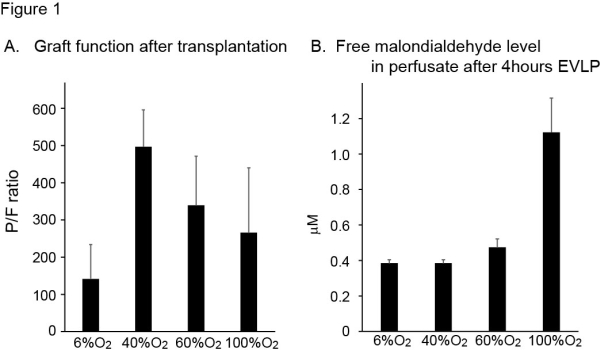Ex Vivo Lung Perfusion: Revisit to the Optimal Oxygenation Circulating Lungs for Graft Preservation
Cardiothoracic Surgery, University of Pittsburgh Medical Center, Pittsburgh, PA.
Meeting: 2015 American Transplant Congress
Abstract number: C251
Keywords: Lung preservation, Lung transplantation, Machine preservation, Oxidant stress
Session Information
Session Name: Poster Session C: Translational Biomarkers and Immune Monitoring
Session Type: Poster Session
Date: Monday, May 4, 2015
Session Time: 5:30pm-6:30pm
 Presentation Time: 5:30pm-6:30pm
Presentation Time: 5:30pm-6:30pm
Location: Exhibit Hall E
Aim
Accumulating evidence supports increasing the role of ex vivo lung perfusion (EVLP). However, there are evidenced limitations as well as the adverse effects of current EVLP on the quality of lung grafts. This study revisited the effects of the different modes of oxygenated perfusate circulating lungs during EVLP, defined their impact on posttransplant functional outcomes, and finally sought for the underlying mechanism to support the optimal oxygenation in the pulmonary circulation from organ preservation standpoints.
Methods
Using rat heart-lung blocks after 1 hour cold preservation, the EVLP system was established with Steen solution at 37°C for 4 hours in a reliable fashion. We compared the results of four different modes of perfusate O2 during EVLP: 6%, 40%, 60% and 100% O2. The evaluation included lung graft function, compliance, and vascular resistance as well as glucose, lactate and other biochemical markers in the perfusate. Following EVLP, all lung grafts were transplanted orthotopically, and posttransplant outcomes were also compared among the groups.
Results
Lungs with 40% O2 on EVLP had the lowest glucose consumption and lactate production, leading to the highest graft function among all groups. Lungs treated with 40% and 60% O2 exhibited significantly reduced proinflammatory cytokines mRNA levels in tissue after 4 hours of EVLP whereas those levels were markedly increased in lungs with 6% and 100% O2. Of note, significantly higher malondialdehyde was identified in perfusate after 4 hours of EVLP with 100% O2. Furthermore, following transplantation, lungs with 40% O2 demonstrated the best posttransplant functional outcomes among the groups.
Conclusions
Lung grafts with deoxygenated perfusate which is the current standard setting during EVLP exhibited significantly increased proinflammatory responses with compromised cellular metabolic activity, resulting in inferior graft preservation leading to compromised posttransplant outcomes. Potential problems with deoxygenated and fully-oxygenated lung grafts due to compromised cellular metabolism and/or oxidative stress were suggested.

To cite this abstract in AMA style:
Noda K, Haam S, D'Cunha J, Luketich J, Bermudez C, Shigemura N. Ex Vivo Lung Perfusion: Revisit to the Optimal Oxygenation Circulating Lungs for Graft Preservation [abstract]. Am J Transplant. 2015; 15 (suppl 3). https://atcmeetingabstracts.com/abstract/ex-vivo-lung-perfusion-revisit-to-the-optimal-oxygenation-circulating-lungs-for-graft-preservation/. Accessed December 25, 2025.« Back to 2015 American Transplant Congress
